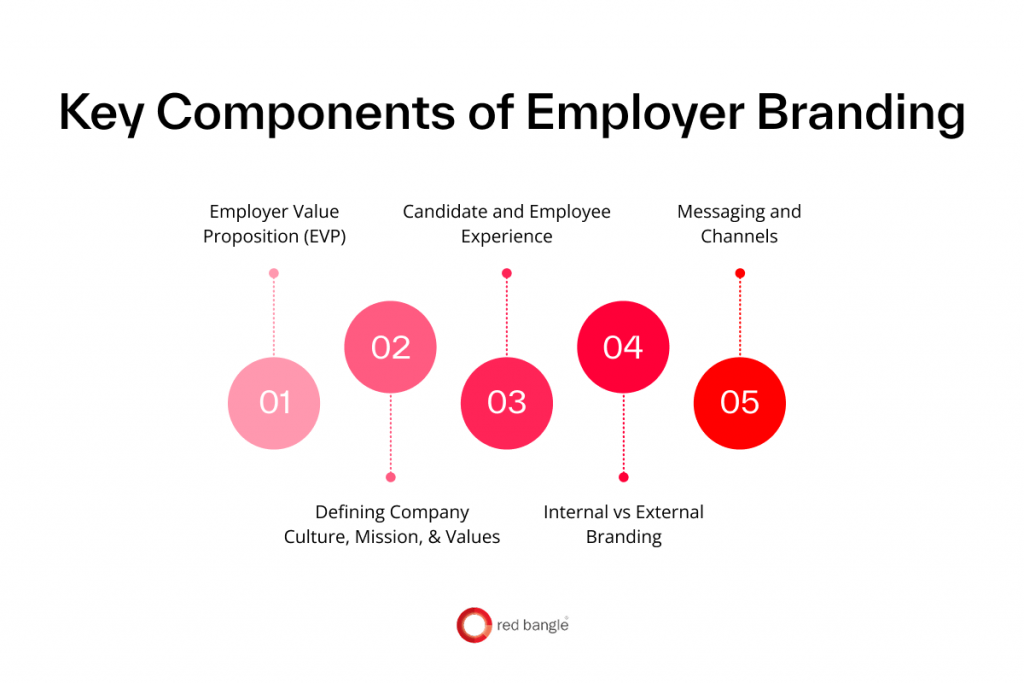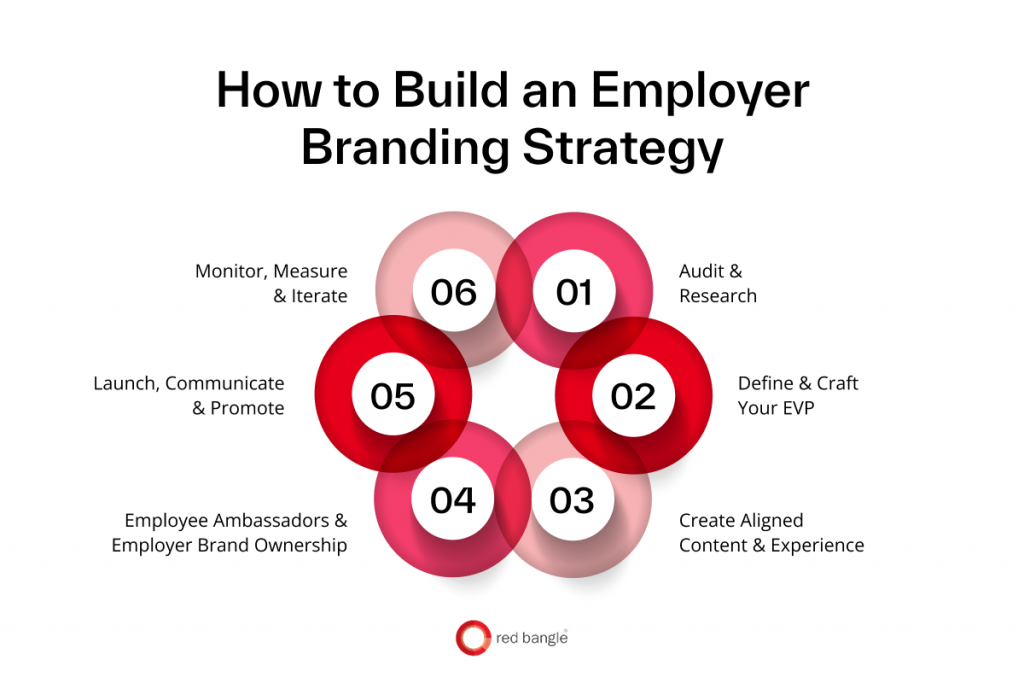Employer Branding Guide 2026: Build a Strong Talent Magnet
Turn your company into a talent magnet in 2025. This employer branding guide shows how to define an authentic EVP, align culture and messaging, lower time-to-hire and hiring costs, and boost engagement, plus real video-led strategies from Red Bangle to make your story stick.

Introduction
Every day, companies lose top candidates to competitors before they even get a chance to interview. Your HR team posts job openings, invests in recruitment ads, and attends career fairs, yet the best talent seems just out of reach.
Meanwhile, employees who could be your most loyal advocates quietly leave for organizations that make them feel seen and valued.
The root of the problem isn’t a lack of opportunity or compensation. It’s perception. How your organization is viewed as an employer can either attract high performers or push them away. This is where employer branding becomes critical.
It’s the lens through which candidates and employees experience your company, shaping engagement, loyalty, and retention. A strong employer brand ensures that the right talent not only applies but also stays, contributing to long-term growth.
For companies looking to tell their employer story visually and authentically, Red Bangle’s guide on creating engaging storytelling videos provides actionable insights on crafting narratives that resonate with both candidates and employees.
In this blog, we’ll explore what employer branding is and why it matters. We’ll also cover how it can help your organization attract and retain talent, reduce turnover, and improve engagement.
What is Employer Branding?
Employer branding is the process of shaping your company’s identity as an employer. It’s a reflection of how current and potential employees perceive your organization, including your culture, values, and work environment.
At its core, employer branding is about creating a reputation as a great place to work, which in turn attracts top talent, boosts employee engagement, and drives retention.
A strong employer brand isn’t just about flashy perks or a great-looking career page. It’s about consistency in communication and authenticity. It starts with understanding your company’s culture and aligning it with the expectations of your target talent pool.
Why Employer Branding Matters
Employer branding is a powerful tool for companies looking to differentiate themselves in a competitive job market. A well-established employer brand can attract top-tier talent, foster employee loyalty, and contribute significantly to business growth.
Many companies focus on their public-facing brand to attract customers. However, employer branding is just as crucial for attracting the right employees who can drive success from within.
Employer Branding for Recruitment Marketing: Benefits for Attracting Talent
Attracting the right talent is becoming increasingly difficult. According to the 2024 Talent Trends Report by SHRM, 77% of organizations and 44% of HR professionals mention that finding top talent has become a major challenge in the last 12 months.
Companies that have developed a strong employer brand stand out in this competitive environment. A robust employer brand speaks volumes to potential hires, indicating that your organization offers a supportive and fulfilling workplace.
This perceived quality can reduce your reliance on traditional recruitment channels, such as job boards and recruitment agencies, ultimately saving time and money.
The better your brand, the more likely you are to attract high-quality candidates. These candidates are more likely to resonate with your company’s values and mission. As a result, instead of spending large sums on external recruiting efforts, companies with a strong employer brand see an organic increase in applications from individuals who already know and trust the company’s reputation.
Red Bangle specializes in turning your employer brand vision into impactful visual narratives. By combining creativity, storytelling, and strategic messaging, we communicate your company culture and value propositions in a way that resonates emotionally and motivates both current employees and prospective talent to engage and act.
Example: Singalong Campaign by RedBangle
A striking example of employee engagement driving employer branding comes from Red Bangle’s AI-powered Singalong campaign for a Fortune 500 client. The challenge was uniting a diverse global workforce in a way that felt personal and participative.
Using AI-based face-swap technology, employees could star in a music video alongside colleagues from around the world, creating a truly interactive experience.
The campaign went beyond entertainment and showcased the company as innovative, people-focused, and forward-thinking. A number of employees participated, sharing their personalized videos and amplifying the company’s culture organically.
For potential candidates, this made the employer brand tangible and credible. It wasn’t just about what the company said. It was about what employees experienced and celebrated.
By turning employees into active brand ambassadors, the Singalong campaign highlighted an engaging, inclusive, and collaborative workplace. This kind of authentic engagement strengthens employer branding, making the organization far more attractive to top-tier talent who value culture, innovation, and recognition.
Employee Engagement & Retention
Employer branding is equally important for retaining your existing employees. A strong employer brand can foster a sense of pride and loyalty among your workforce, leading to higher levels of engagement.
When employees feel that their company values them, they are more likely to stay, reducing turnover rates.
Recognition and onboarding play a critical role in this process. According to The Human-centered Workplace Research by Gallup, well-recognized employees are 45% less likely to leave the company within two years, highlighting the importance of acknowledgment and appreciation in retention.
Similarly, according to a Deloitte research report, a positive onboarding experience increases the likelihood that employees will stay for at least three years by 69%, emphasizing how the initial experience shapes long-term engagement and loyalty.
Employees who feel engaged and aligned with their company’s values are less likely to seek new opportunities, leading to cost savings in recruitment, training, and onboarding.
Reducing Hiring Cost & Time-to-Hire
Another significant benefit of employer branding is its ability to reduce hiring costs and time-to-hire. Companies with a strong employer brand attract more qualified applicants through inbound channels, reducing the need for expensive job postings.
When top talent is already aware of your company and its culture, the hiring process becomes more efficient. Candidates who are already interested in working for your company are more likely to apply directly, which reduces the time needed to screen and interview candidates.
Strong employer branding, coupled with an effective recruitment marketing strategy, ensures that your hiring process runs smoothly and more cost-effectively.
For large enterprises competing for niche or executive talent, a strong employer brand creates a decisive edge. When your reputation precedes you in the talent market, candidates are more likely to engage directly. This reduces dependency on third-party search firms and cuts both recruitment costs and hiring timelines.
Employer Branding to Promote Company Culture
One of the most significant aspects of employer branding is its ability to showcase a company’s culture. Employer branding is the perfect platform for communicating your company’s values to both current and prospective employees.
When done correctly, employer branding provides candidates with a transparent view of what it’s like to work at your company. This is an essential step in ensuring that potential employees align with your organization’s culture before they even apply.
Employer branding is a strategic investment that pays dividends across multiple facets of a business. From attracting top talent to retaining high-performing employees, employer branding is integral to a company’s success.
If your company has yet to focus on employer branding, now is the time to start because a strong employer brand is no longer just an asset; it’s a necessity.
Key Components of Employer Branding

Understanding the key components of employer branding is critical for building a strong, credible brand that resonates with both candidates and current employees.
Employer Value Proposition (EVP)
The Employer Value Proposition is the cornerstone of any employer branding strategy. It represents the promise you make to your employees in exchange for their skills, commitment, and loyalty.
A strong EVP articulates the tangible and intangible benefits employees receive, including competitive compensation, career growth opportunities, professional development, work-life balance, and an inclusive culture.
A compelling EVP clearly differentiates your organization from competitors and addresses the expectations and priorities of your target talent pool. Companies often struggle to define an EVP because it requires aligning business objectives with the lived experience of employees.
A great way to see an EVP in action is through Red Bangle’s work with Infosys on their Global Leaders series. This campaign brought the EVP, “Move Forward. Take The World With You,” to life.
By telling the stories of leaders from different regions, this video series showed how career growth, global opportunities, and an inclusive culture actually translate into everyday experiences for Infosys’ employees. Each leader shared personal journeys, challenges, and successes, connecting the brand promise to real-life outcomes.
The brilliance of this approach lies in its authenticity. Instead of just stating that Infosys values diversity, innovation, and collaboration, the campaign demonstrated it. Potential hires could see themselves in these stories, understanding not just what the company offers but how it empowers employees to grow, lead, and make an impact globally.
It’s a perfect example of how a well-defined EVP can differentiate an organization, resonate with the right talent, and turn abstract promises into tangible, relatable experiences.
Defining Company Culture, Mission, and Values
Culture is the backbone of employer branding. It shapes every interaction employees have with your organization and influences how candidates perceive your workplace. Clearly defining a company’s culture involves articulating its mission, core values, work environment, and guiding principles for behavior and decision-making.
Transparency, inclusion, and employee well-being are critical elements that contribute to a positive culture. Companies that emphasize these aspects often see higher engagement and lower turnover because employees feel that their work environment aligns with their personal values.
A defined culture also helps filter potential candidates. When your brand communicates its values clearly, candidates can self-assess alignment before joining, reducing the risk of cultural mismatch and improving long-term retention.
Example: Treebo Recruitment Film by Red Bangle
Every company has a story, but few communicate it effectively to attract talent. For Treebo Hotels, Red Bangle’s ‘Hotel Superhero’ video brought their culture and mission to life.
Instead of simply listing perks or job roles, the video highlighted how Treebo’s mission, to elevate budget travel while delivering delightful guest experiences, shapes every aspect of the workplace.
By showcasing the team in action and demonstrating their commitment to quality service, the campaign gave candidates a clear sense of the company’s values, work environment, and the kind of dedication it expects from its employees.
This approach lets potential hires experience the culture visually and emotionally. Candidates can see themselves contributing to a company that prioritizes teamwork, guest satisfaction, and innovation.
By communicating its mission and values authentically, Treebo not only attracted talent aligned with its culture but also reduced the risk of cultural mismatch, ensuring new hires are engaged and committed from day one.
Candidate and Employee Experience
Employer branding is experienced both by candidates before they join and employees after they are onboarded. The candidate experience encompasses all interactions a job seeker has with your company, from job advertisements and career websites to interviews and onboarding.
Example Use Case:
Every employee’s journey starts somewhere. Darwinbox’s employer branding video by Red Bangle tells that story through the eyes of a new recruit, illustrating onboarding, career progression, and day-to-day experiences.
The video takes viewers on a journey through a new hire’s tenure, showing how employees are onboarded, how they grow, and how their experiences are carefully streamlined from day one. By presenting the process through the lens of a recruit, the campaign makes the experience relatable for prospective employees.
Candidates get a clear sense of what it’s like to join the company, from initial onboarding to long-term development, while current employees see how structured, supportive, and transparent processes reinforce a positive workplace culture.
To translate complex employee journeys into clear and engaging visual experiences, you can explore Red Bangle’s complete guide on creating explainer videos, which shows how videos can simplify onboarding and communicate culture effectively.
A seamless, respectful, and transparent process signals that your organization values talent and sets the tone for the employee experience.
Employee experience covers the daily life of employees, including workplace environment, team dynamics, recognition programs, growth opportunities, and management practices. Ensuring consistency between what candidates expect and what employees experience is essential for authenticity.
Organizations that focus on improving both candidate and employee experiences reduce turnover and strengthen word-of-mouth referrals.
Internal vs External Branding
Employer branding is effective only when internal and external branding are aligned. Internal branding focuses on engaging current employees by communicating the company’s mission, values, and career opportunities. It ensures that employees understand the brand promise and feel empowered to embody it in their work.
External branding targets potential employees, highlighting the organization as a desirable workplace through messaging, storytelling, and marketing campaigns. The alignment of internal and external branding ensures authenticity.
Employees who are genuinely engaged and feel valued become brand ambassadors, sharing their experiences through social media, reviews, and professional networks.
Messaging and Channels
The effectiveness of employer branding heavily relies on consistent messaging and strategic use of communication channels. Every touchpoint, from career pages and social media profiles to email communications, should reflect the company’s culture, mission, and values.
Storytelling is a particularly powerful tool. Employee stories, case studies, day-in-the-life videos, and blogs give prospective hires an authentic view of the organization and reinforce trust.
Platforms like LinkedIn, Glassdoor, and company career portals are essential for disseminating these narratives, but consistency is critical. Messaging should remain aligned across channels to avoid confusion or misrepresentation of the workplace culture.
A deliberate focus on these elements allows organizations to attract the right talent and retain valuable employees.
How to Build an Employer Branding Strategy

Building a strong employer brand requires a structured approach that aligns with business goals and addresses the real challenges faced by candidates and employees.
Effective employer branding is a continuous process of understanding perceptions, communicating value, and creating experiences that resonate. Each step in the strategy contributes to attracting top talent, retaining employees, and enhancing overall business performance.
Audit & Research
The foundation of any employer branding strategy is understanding how your organization is currently perceived. This starts with conducting a comprehensive audit. Collect feedback from current employees through surveys, interviews, and focus groups to gauge satisfaction and perceptions of the workplace culture.
Equally important is gathering insights from candidates who have recently applied or been rejected, as their experience can highlight gaps or pain points in the recruitment process.
Online reviews and employer rating platforms, such as Glassdoor and Indeed, provide additional visibility into public perception. Monitoring social media conversations and professional forums can reveal broader sentiment about the company as an employer.
This research not only identifies strengths to highlight but also exposes weaknesses that need to be addressed.
Define & Craft Your EVP
Once the audit is complete, the next step is defining your Employer Value Proposition. The EVP articulates what makes your company unique as a workplace and explains why employees should choose and stay with your organization.
It should encompass tangible benefits such as salary, benefits, and career development, as well as intangible aspects like culture, work-life balance, and company mission.
Example Use Case:
A compelling way to make an EVP tangible is through direct insights from the people who shape your workforce. Infosys’ “Know Your Recruiter” series by Red Bangle does exactly this, giving candidates a front-row seat to what recruiters look for, what they value in employees, and how the company culture comes alive in daily work.
By hearing directly from recruiters, prospective hires gain clarity on expectations, growth opportunities, and the values that guide the organization.
This approach bridges the gap between abstract promises and real experiences. Candidates don’t just read about career development or inclusive culture. They see how these principles play out in the workplace.
It reinforces authenticity in the EVP, helping ensure alignment between what the company offers and what employees experience, ultimately strengthening credibility, attracting the right talent, and supporting long-term retention.
A strong EVP aligns with employee expectations and reflects the real experience within the company. If there is a disconnect between the EVP and the actual workplace experience, it can damage credibility and harm recruitment and retention efforts.
Create Aligned Content & Experience
The EVP must be communicated through engaging content that reflects your culture authentically. This includes employee stories, blog posts, videos, testimonials, and case studies. The content should provide insight into day-to-day work life, career progression, and employee achievements, offering a realistic view of the workplace.
Content distribution should be seamless across multiple channels, including your career website, social media, recruitment portals, and even internal newsletters. Providing this transparency not only attracts candidates but also reinforces engagement and loyalty among existing employees.
For brands seeking professional support in developing these campaigns, Red Bangle’s B2B brand campaign agency offers end-to-end solutions, from strategy and creative direction to video production. This ensures that your EVP is showcased consistently across all channels and resonates with both current employees and future hires.
Employee Ambassadors & Employer Brand Ownership
Employees are among the most credible voices of an organization. Empowering them to share their authentic experiences strengthens the employer brand’s credibility. Employee advocacy programs can provide structured ways for employees to participate, whether by sharing personal stories on social media or participating in recruitment events.
Example Use Case:
The most convincing employer brand ambassadors are your own employees. Zyeta’s Employee Ambassador Program by Red Bangle showcases this perfectly. Employees from different functions share their real experiences, illustrating the company culture, values, and collaboration in action.
By hearing directly from employees about the values, collaboration, and day-to-day work environment, candidates get a vivid, authentic view of life inside the organization.
This kind of storytelling turns employees into genuine brand ambassadors. When team members share their experiences, it strengthens credibility and shows that the company lives up to its promises. It also encourages other employees to take ownership of the brand, ensuring that internal culture and external messaging remain aligned.
Programs like Zyeta’s demonstrate how employee advocacy can make an employer brand not just a statement, but a lived experience that attracts and retains the right talent.
Conversations among marketing professionals on community discussions show that employee stories are one of the most effective ways to showcase culture. Teams taking over LinkedIn for a day, sharing real work experiences, or celebrating personal achievements make values tangible.
Initiatives like gamified advocacy programs and spotlighting community work turn culture into something visible and relatable. By putting employees front and center, companies demonstrate their mission in action, making their workplace more attractive to candidates who value authenticity.
Leadership involvement is also crucial. HR, marketing, and senior management should work together to maintain alignment between internal culture and external messaging. When employees actively embody and communicate the company’s values, the employer brand becomes more authentic and compelling.
Launch, Communicate & Promote
After establishing the strategy and content, the next step is to launch and communicate the employer brand internally and externally. Internal launches ensure that employees understand and embrace the brand, making them advocates rather than passive participants.
External communication should be multi-channel, leveraging career pages, social media, recruitment events, and company blogs. Consistency across these channels is critical to avoid mixed messages.
Tailoring content for different audiences, such as early-career candidates versus experienced professionals, also helps improve relevance and engagement.
Monitor, Measure & Iterate
Employer branding requires ongoing monitoring and refinement. Metrics such as employee engagement scores, retention rates, and candidate application quality provide insights into the effectiveness of your strategy.
Additionally, monitoring reviews and feedback on platforms like Glassdoor can highlight emerging challenges or trends. Based on these insights, companies should iterate on their messaging to ensure the employer brand remains authentic.
Employer branding is an ongoing effort that requires consistent evaluation and adjustment to meet the needs of both your employees and candidates.
How to Measure the Success of Employer Branding?
Measuring the impact of employer branding is critical to ensure your strategies are working and delivering tangible business value.
Candidate Metrics
The first place to look is your talent pipeline. Metrics like the number and quality of applicants indicate whether your employer brand is attracting the right people. Tracking time-to-hire helps evaluate whether your brand is reducing friction in recruitment, while source of hire shows which channels are most effective for promoting your employer brand.
Companies with strong employer brands often see more inbound applications from high-quality candidates, reducing reliance on paid advertising or recruiters.
Employee Metrics
Your employer brand is equally reflected internally. Monitoring retention and turnover rates reveals whether employees feel valued and aligned with your culture. High engagement scores are another key indicator, demonstrating that employees are motivated, productive, and invested in the company’s success.
Internal mobility, such as promotions and lateral transfers, also signals that employees trust the organization to support their growth. Together, these metrics indicate the strength of your EVP in practice and highlight areas where your brand experience can be improved.
Employer Brand Perception
External perception is just as important as internal experience. Review scores on platforms like Glassdoor and LinkedIn provide an unfiltered view of how candidates and employees perceive your company.
Surveys targeting both current employees and applicants can reveal sentiment, satisfaction, and alignment with your stated values. Consistent positive feedback indicates a strong, authentic employer brand, while negative trends highlight opportunities for improvement.
ROI Metrics
Employer branding is an investment, and like any investment, its ROI should be measurable. Tracking cost per hire and overall hiring budget savings helps quantify financial benefits.
Strong branding often leads to faster hires with better cultural fit, which translates into reduced onboarding costs and lower turnover-related expenses.
In addition, enhanced employee engagement and satisfaction often drive productivity improvements, further demonstrating the business value of a strong employer brand.
Digital Metrics
Your online presence provides measurable signals of employer brand reach and effectiveness. Monitoring traffic to your career page, engagement on social media posts, and brand mentions in professional forums or news outlets can indicate how well your messaging resonates externally.
High digital engagement often correlates with stronger brand awareness, more qualified applicants, and increased interest in your company as an employer of choice.
Conclusion
Companies with well-defined and authentically communicated employer brands create an ecosystem where employees are motivated to contribute, innovate, and advocate for the organization.
Beyond recruitment, a strong employer brand reduces hidden costs associated with disengagement, turnover, and inefficient hiring processes, while simultaneously enhancing employee productivity and alignment with business goals.
Investing in employer branding also positions organizations to respond proactively to workforce shifts, such as the increasing demand for purpose-driven workplaces and flexible, inclusive environments.
Organizations that prioritize transparency, recognition, and career development cultivate loyalty and resilience, creating a workforce capable of adapting to evolving challenges. In essence, employer branding transforms a company from a transactional employer into a destination workplace, where engagement, retention, and long-term business outcomes reinforce each other.
Ready to showcase your company culture and attract top talent?
Book a demo call with Red Bangle today and discover how our employer branding videos can tell your story authentically, engage employees, and elevate your recruitment strategy.



